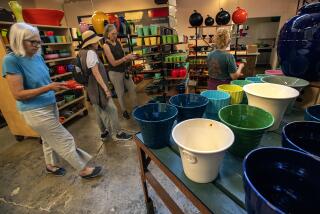Silversmith Shows His Mettle : Award-Winning Designer Is Trying to Preserve His Long-Honed Craft for Future Generations
Allan Adler’s publicist wants to make one thing clear.
A tea service crafted by Adler in the 1940s never sold for $1 million at a Sotheby’s auction in 1989 in New York. The last of a dwindling breed of silversmiths, Adler has been profiled in various publications for 50 years.
“It was only $50,000,” said Mike Venema, Adler’s publicist, adding that the set was solid gold, somewhat of a design detour for Adler, who works primarily in silver.
A mere pittance, of course--that $50,000, compared with the more astounding $1-million price tag.
But Adler, 75, is quick to point out that a tiny creamer created by Paul Revere sold recently at auction for $50,000. “So in a generation or two, that $1-million price might not be out of bounds,” Adler said.
John Kovacs, head of silver at Butterfield & Butterfield Auctioneers in Los Angeles, agreed. “Allan Adler is one of the very last around to do hand silver work,” said Kovacs, who auctions four to six Adler flatware sets each year. “His work has been popular, and in the future it will be extremely collectible, with unique items bringing top interest and top dollar.”
Future generations may have to visit museums to see the work of such silversmiths as Adler, who prefers to keep the exact location of his north Valley workshop under wraps for fear of being interrupted by uninvited visitors.
Adler’s work, in fact, has been shown in the Los Angeles County Museum of Art and in New York’s Museum of Modern Art, where his sterling water pitcher captured an award in 1956. In 1982, Adler was honored by the Smithsonian Institution for his contributions to design during the 1940s and ‘50s.
To help preserve the art of silversmithing, Adler recently announced plans to construct an eight-room workshop and his own Spanish villa-style museum near Valencia. Adler, who lives in Studio City and sells his creations at Gumps in Beverly Hills and at his own stores in Corona del Mar and La Jolla, expects to begin construction next year.
“I’m planning to put my life’s work in there, along with items that relate to the history of silversmithing, like tools handed down to me through generations,” Adler said.
Works by Adler that may eventually be shown at his museum include a silver hairbrush commissioned by Winston Churchill’s daughter for her father, flatware for the governor’s mansion in Sacramento, an Aladdin’s lamp given by the craftsman to actress Margaret Sullivan, a score of tea sets, flatware and jewelry created for celebrities, Silver Star statuettes forged for the American Film Institute and silver NASA pins that orbited the Earth along with the seven Mercury astronauts.
Adler occasionally works in gold, and over the years has turned out scores of one-inch, solid-gold Oscar mementos commissioned by the Academy of Motion Picture Arts and Sciences for Oscar winners who request them.
Anxious to expand into a new, larger space, Adler was vocal about the limitations of the two-bedroom bungalow-turned-workshop that he now occupies. But the bungalow, he said, provides a sense of history for his crew of five, all journeyman or apprentice silversmiths. His father-in-law, Porter Blanchard, a seventh-generation silversmith to whom Adler was apprenticed at age 24, worked out of the same house from the early 1940s until Blanchard’s retirement in 1978.
Adler took up residence 11 years ago when his Sunset Boulevard shop, also formerly owned by Blanchard, went up in flames. It was in the Sunset Boulevard shop in 1940 that Adler first fashioned and sold his pieces, often taking time out to instruct such private students as Sullivan and Katharine Hepburn.
A lucrative defense contract followed as the nation entered World War II. With the help of 25 silversmiths, he produced miles of silver tubing for then top-secret radar equipment. Just after the war, Adler began to make a name for himself and his contemporary creations.
He describes his work--which includes such pieces as a teardrop-shaped coffee and tea service and a starlit-pattern sugar and creamer set--as “clean lines with a bent toward the unconventional.”
Flatware comprises about a third of Adler’s output (one six-piece place setting costs $1,200), holloware (such as coffeepot, bowls and cups) takes up another third and jewelry the final third--totaling annual gross sales of about $500,000.
Adler’s jewelry designs range from simple rings with offset stone settings to an intricate belt he created for Michael Jackson to wear on tour.
When Adler hammered out his first flatware set in the early 1940s, silver sold for 29 cents an ounce. In the late 1970s, the metal shot up to $48 an ounce (during a time when brothers Lamar and Herbert Hunt of Texas manipulated silver market prices), and today Adler pays about $4 an ounce. The silver arrives at his shop in three-foot-long sheets that Adler’s crew melts down into book-sized ingots in a makeshift furnace.
The work is tedious. Ralph Walker, 82, a colleague and one of Adler’s apprentices, demonstrated the incessant pounding needed to fashion a fork. Lifting one of a dozen five-pound hammers he uses (“you can develop quite an arm in this business”), Walker began hammering a long strip of metal. The metal is occasionally softened by heating. A single fork takes three to four hours to complete.
Adler describes the work as “moving the metal.”
“One end of the hammer is used to compress the silver, making it harder,” he said. “And the other end, more pointed, stretches it out, thinning it to the shape you want.”
Other machines in Adler’s shop help move the metal a bit faster. Most are lumbering, noisy contraptions that Adler said date back to the late 18th Century. They include a power rolling mill, a flatware blanking press, a drop hammer used to form spoon bowls and a belt-driven spinning lathe.
Adler clapped a wooden maple chuck on the lathe and turned the machine on. Placing a square sheet of silver over the chuck, he wedged a lengthy steel-tipped forging tool underneath his arm. Shifting his weight and making innumerable calculations about the amount and placement of pressure, he plied the silver over the spinning, bowl-shaped chuck, smiling as a silver gleam melted like taffy over the form.
“It’s the same concept used in a potter’s wheel,” Adler shouted over the din. “The only difference is that a potter’s wheel is upright, and this lathe is turned on its side.”
Adler makes no pretense about his work. “A silversmith is just like a blacksmith,” he said. “It means a lifetime of pounding and shaping. It takes about five years to complete an apprenticeship. Even after all that, most craftsmen don’t have an eye for design. I’m here now basically for them to ask me what I think” of their work and designs, he said. “Even if they have a design they make over and over again, they’re apt to alter it slightly.”
Adler puts in a 40-hour week, but has no plans to retire. He cherishes the weekends he spends on his 75-foot 1916 sailing ketch moored in Newport Beach that he and his wife, Rebecca, purchased in 1954 and have restored.
Adler’s two main competitors--who produce primarily flatware--are his own relatives. Porter Blanchard Silversmiths--originally owned by Blanchard’s other son-in-law, Louis Wise--has employed five silversmiths in its Calabasas shop since 1950. Old Newbury Crafters in Amesbury, Mass., originally owned by a Blanchard brother, has offered 26 flatware patterns, ranging from medieval to modern, since 1915.
There were once about 50 silversmiths in the United States, according to the Sterling Silversmiths Guild of America. Although silversmiths seem to be a vanishing breed, the Sterling Silversmiths Guild of America reports that student entries for its annual design competition nearly doubled in the past year. This year, the Baltimore-based guild received 114 entries ranging from flatware to wall sculpture from 40 universities, double the number of entries in 1990.
“The high interest is partly due to the fact that price of silver is at a 16-year low,” said guild Vice President Bob Johnston. “It’s hard to tell if there are any Adlers in the bunch. It takes patience and dedication to achieve such a household name as his. Not many have that much interest today.”
The popularity of silver items has decreased partly because “people just don’t want to bother cleaning it,” Kovacs said.
“But it’s actually a bargain,” Adler said. “Yes, there’s not a whole lot of people who can afford to spend $15,000 for a set of flatware, but things made of silver are really worthwhile, not like a car that wears out. The longer silver is around, the more valuable it gets.”
More to Read
Inside the business of entertainment
The Wide Shot brings you news, analysis and insights on everything from streaming wars to production — and what it all means for the future.
You may occasionally receive promotional content from the Los Angeles Times.










